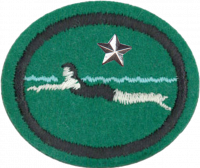AY Honor Swimming - Beginner - Advanced Requirements
Skill Level
1
Year
1963
Version
06.12.2025
Approval authority
General Conference
Prologue: Receive the American Red Cross Level IV Stroke Development or YMCA certificate or equivalent in Swimming – Beginner's Advanced OR pass the following requirements:
1. Bobbing. Practice bobbing in neck-deep water prior to going into deep water. Demonstrate bobbing in deep water with a definite rhythm, inhaling when the mouth clears the water and exhaling as the head goes below the water.
2. Breath Control. Stand in chest-deep water and demonstrate rhythmic breathing at the rate of 24 to 26 times in two minutes.
3. Swimming in Place. Remain afloat in a confined area (within an eight-foot circle) by using a modified human stroke for a period of one minute.
4. Changing Positions. Change from a prone swimming position to a vertical position and then to a supine position. Change from a supine to a vertical position, and then to a prone position.
5. Elementary Backstroke. Swim 25 yards (22.9 meters) using the elementary back stroke.
6. Crawl Stroke. Swim 25 yards (22.9 meters) using the crawl stroke.
7. Survival Stroke. Swim 25 yards (22.9 meters) using the survival stroke.
8. Use of Personal Flotation Device. Jump into water from a deck or dock while wearing a personal flotation device. Show how to be comfortable while in the prone, vertical, and supine positions. Each position should be held for at least one minute. Use a seat cushion to support the body correctly in the water.*
9. Survival Float. In deep water over the head, do a survival float for two minutes.
10. Know how to release a cramp while in deep water.
11. Rescue Technique. Demonstrate a rescue involving the use of a reaching pole and one involving the use of an article of clothing.
12. Combined Test. Dive into deep water from a deck or dock, swim a minimum of three body lengths below the surface, come to the surface, and stay afloat in a confined 20 yards (18.3 meters) using either the elementarybackstroke or crawl stroke.
13. Know the causes of and methods for the prevention of accidents that can occur in or near the water.
14. Demonstrate artificial respiration.


